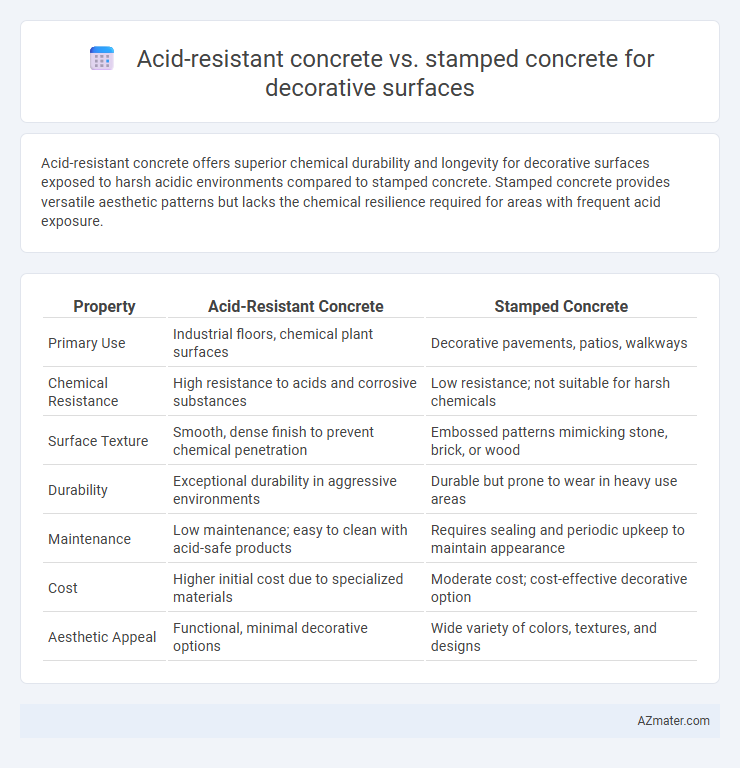Acid-resistant concrete offers superior chemical durability and longevity for decorative surfaces exposed to harsh acidic environments compared to stamped concrete. Stamped concrete provides versatile aesthetic patterns but lacks the chemical resilience required for areas with frequent acid exposure.
Table of Comparison
| Property | Acid-Resistant Concrete | Stamped Concrete |
|---|---|---|
| Primary Use | Industrial floors, chemical plant surfaces | Decorative pavements, patios, walkways |
| Chemical Resistance | High resistance to acids and corrosive substances | Low resistance; not suitable for harsh chemicals |
| Surface Texture | Smooth, dense finish to prevent chemical penetration | Embossed patterns mimicking stone, brick, or wood |
| Durability | Exceptional durability in aggressive environments | Durable but prone to wear in heavy use areas |
| Maintenance | Low maintenance; easy to clean with acid-safe products | Requires sealing and periodic upkeep to maintain appearance |
| Cost | Higher initial cost due to specialized materials | Moderate cost; cost-effective decorative option |
| Aesthetic Appeal | Functional, minimal decorative options | Wide variety of colors, textures, and designs |
Introduction to Decorative Concrete Surfaces
Decorative concrete surfaces combine functionality with aesthetics, enhancing both durability and visual appeal in various applications. Acid-resistant concrete offers superior protection against chemical corrosion, making it ideal for industrial environments, while stamped concrete mimics natural materials with customizable patterns and colors for residential or commercial spaces. Choosing between these types depends on specific exposure conditions and design preferences, ensuring long-lasting beauty and resilience.
Defining Acid-Resistant Concrete
Acid-resistant concrete is a specially formulated mixture designed to withstand exposure to acidic environments, making it ideal for industrial and chemical applications where corrosion resistance is critical. Unlike stamped concrete, which primarily serves decorative purposes by mimicking natural stone or brick patterns, acid-resistant concrete prioritizes durability and chemical stability to prevent surface degradation. Key components such as low permeability cement, acid-resistant aggregates, and chemical additives enhance its resistance to acids, distinguishing it from standard decorative concrete options.
Understanding Stamped Concrete
Stamped concrete offers a versatile and cost-effective solution for decorative surfaces, replicating the appearance of natural stone, brick, or wood with durable concrete. Unlike acid-resistant concrete, which is specially formulated to withstand chemical corrosion in industrial environments, stamped concrete emphasizes aesthetic appeal and texture customization while maintaining moderate resistance to wear and weather. Choosing stamped concrete enhances outdoor patios, walkways, and pool decks by providing visually striking patterns combined with practical strength and longevity.
Key Material Differences
Acid-resistant concrete is formulated with specialized cement and aggregates resistant to chemical corrosion, often incorporating silica fume, polymer additives, and low-permeability binders to withstand acidic environments. Stamped concrete relies on standard concrete mixes modified with color pigments and release agents, featuring surface patterns created by stamping tools for aesthetic appeal rather than chemical resistance. The primary material distinction lies in acid-resistant concrete's enhanced chemical durability, whereas stamped concrete emphasizes decorative texture and color without inherent acid resistance.
Durability and Longevity Comparison
Acid-resistant concrete exhibits superior durability and longevity compared to stamped concrete, particularly in environments exposed to corrosive chemicals, as it is engineered to withstand acidic degradation and maintain structural integrity over time. Stamped concrete, while visually appealing and versatile for decorative surface applications, typically has a lower resistance to chemical wear and may require more frequent sealing and maintenance to prevent surface deterioration and cracking. For long-term performance in harsh chemical conditions, acid-resistant concrete offers enhanced resilience and reduced maintenance costs relative to stamped concrete.
Aesthetic Versatility and Design Options
Acid-resistant concrete offers superior durability for environments exposed to harsh chemicals, but it typically features a limited range of colors and textures compared to stamped concrete. Stamped concrete excels in aesthetic versatility with customizable patterns and color blends, allowing designs that mimic natural stone, brick, or wood for a highly decorative surface. For projects prioritizing intricate design options and visual appeal, stamped concrete provides broader creative flexibility, while acid-resistant concrete is preferred where chemical longevity is critical.
Cost Analysis: Acid-Resistant vs Stamped Concrete
Acid-resistant concrete typically incurs higher initial costs due to specialized materials like silica fume and chemical additives that enhance durability against corrosive environments. Stamped concrete offers a cost-effective decorative surface option with lower material and installation expenses, making it popular for aesthetic applications without harsh chemical exposure. Long-term maintenance costs of acid-resistant concrete can be lower in industrial settings, while stamped concrete may require periodic sealing and repairs to maintain its appearance and structural integrity.
Installation Process and Timeframes
Acid-resistant concrete requires a specialized installation process involving chemical-resistant aggregates and precise curing conditions to ensure durability against corrosive substances, often extending the curing time to 7-14 days. Stamped concrete involves pouring a standard concrete slab followed by imprinting patterns and textures during the initial set, allowing for quicker installation and usability within 48-72 hours. The detailed finishing steps and protective sealers in stamped concrete accelerate project completion compared to the meticulous preparation needed for acid-resistant concrete.
Maintenance Requirements for Each Type
Acid-resistant concrete requires specialized cleaning agents and regular inspections to prevent surface degradation from chemical exposure, ensuring longevity in harsh environments. Stamped concrete demands routine sealing every 2-3 years to protect the decorative patterns from wear, moisture, and fading caused by UV rays. Both surfaces benefit from prompt stain removal, but acid-resistant concrete typically has a more rigorous maintenance protocol due to its industrial application needs.
Ideal Applications and Best Use Cases
Acid-resistant concrete is ideal for industrial environments exposed to corrosive chemicals, including chemical storage areas, wastewater treatment plants, and laboratories, due to its high durability against acidic damage. Stamped concrete excels in decorative applications such as patios, walkways, and interior floors where aesthetic appeal and texture variety are prioritized. Choosing between the two depends on the balance between functional chemical resistance and customizable decorative finishes.

Infographic: Acid-resistant concrete vs Stamped concrete for Decorative surface
 azmater.com
azmater.com